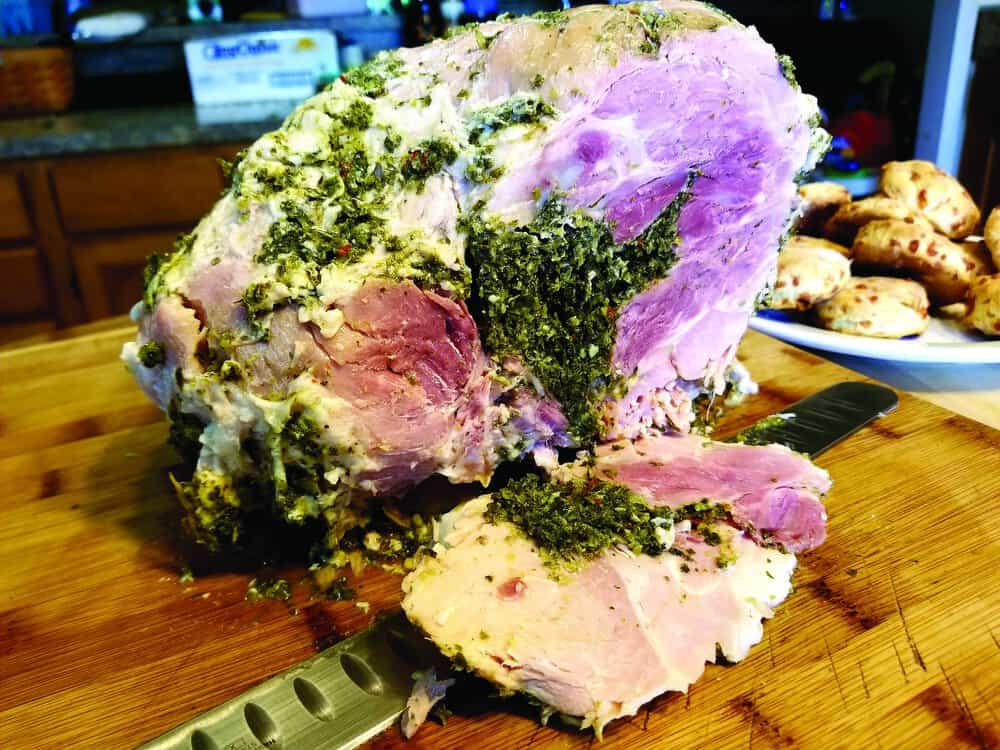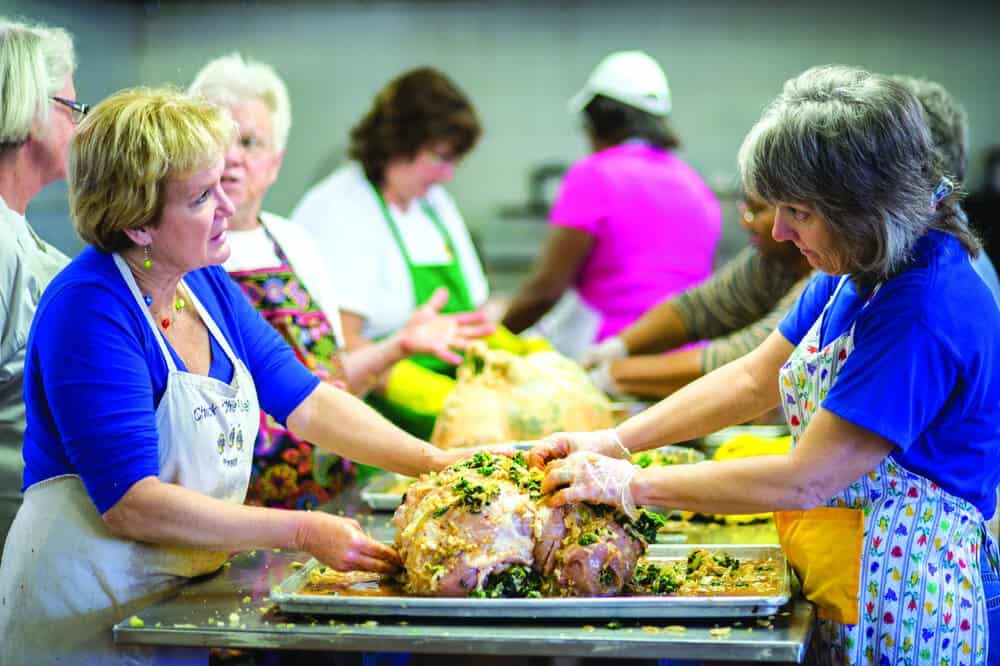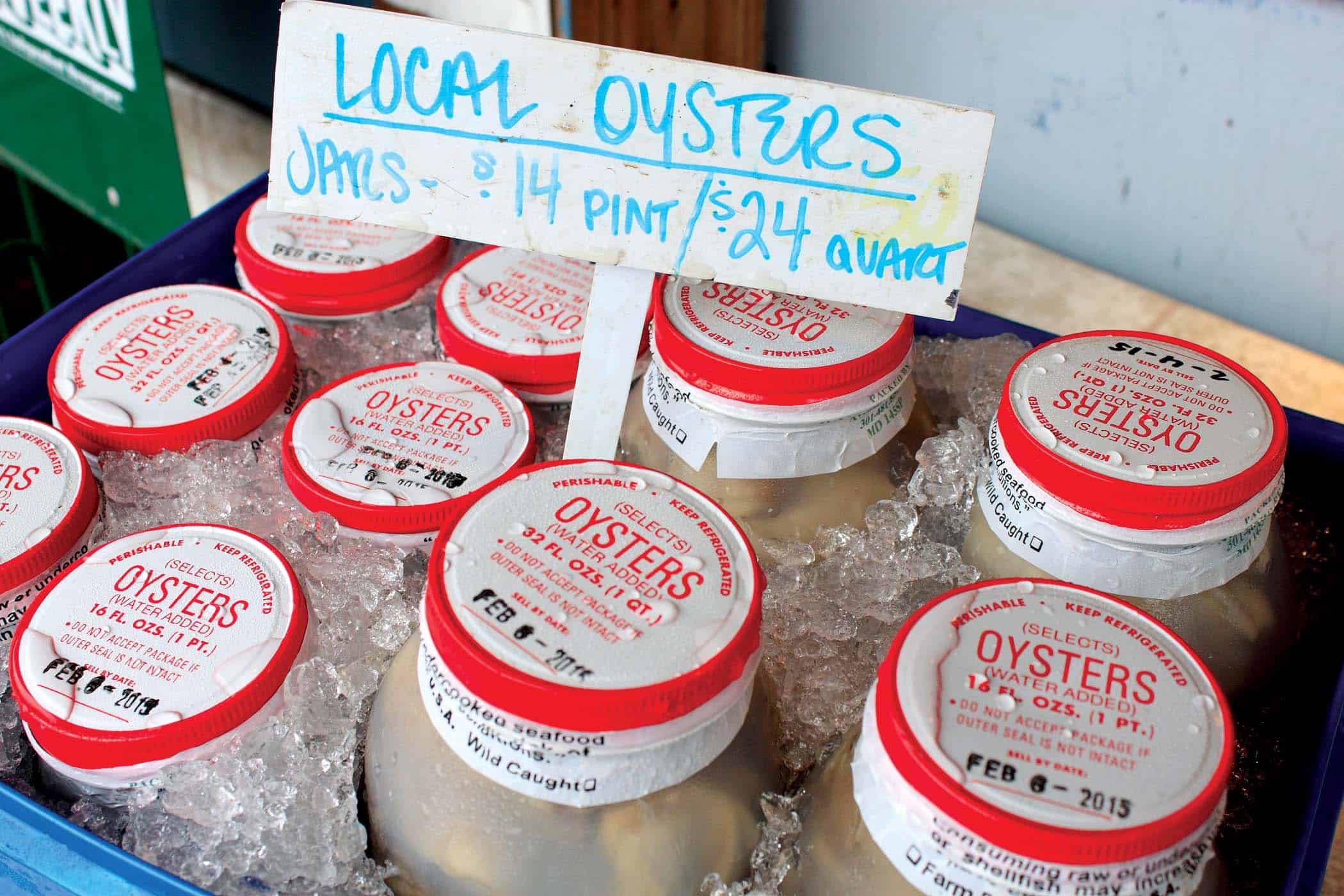Maryland stuffed ham is a lot of work, but worth it
By Henry Hong
St. Mary’s County is the center of the stuffed ham universe—well, it is the stuffed ham universe. On the southern tip of Maryland, western side of the bay, a few markets sell this hyper-local delicacy ready-made and year-round, as it is often consumed sliced as a sandwich meat. Chaptico Market, W.J. Dent & Sons, Murphy’s Town & Country Store, and Brandy Farms (in Gambrills) are the best known. Local supermarkets will also carry it, but usually only during the holidays, and for stuffed ham, the holiday of choice is Easter. For those of us who don’t live in or near that area, home cooking is the logical course of action. Unfortunately, the main ingredient is also difficult to find elsewhere in Maryland—corned fresh ham. And while often the rarity of a thing is what makes that thing desirable, Southern Maryland stuffed ham is actually a pretty spectacular dish in every sense of the word.
The corning process is very straightforward; just salt and time, really. In the case of a modern corned ham, Prague powder #1, or pink salt, which contains sodium nitrite, is used to preserve the color and impart the flavor that is associated with cooked ham. For a whole 20-pound ham, that’s a curing time of about two weeks, and it takes up a lot of room in the fridge. Unless you’ve got the time and space, plan on acquiring a real corned ham.
I am lucky enough to work with someone originally from Leonardtown, Maryland, who lives across the street from me, and whose mom happened to be visiting at just the right time. She was able to stop by her local McKay’s supermarket and pick up a 24-pound corned ham ($2.99 per pound) just in time to cook for this article. It comes with the skin off and fully brined, much like corned beef but minus any spices or other flavoring agents. My ham also came with the bone removed (but thoughtfully included), which forced my hand in the slit versus bone-cavity debate.
The stuffing has to go somewhere, and there are two main styles of cavity creation. The way it is referenced in most in old recipes, and by old we’re talking 18th century or better, is to cut slits all over the surface of the ham, into which stuffing is crammed, resulting in a sort of Jell-O poke-cake effect. The other way is to debone the ham and fill the hole with stuffing, which is basically a braciole, as an Italian friend and taste-tester pointed out. The knock on removing the bone is that flavor is lost as a result, but the ham has already been cured, and will be boiled, so in my view, the greater volume of stuffing contained within the ham is far more valuable than any nuances that the bone might contribute to flavor.
The stuffing is what really makes this dish special. One theory about the origin of stuffed ham and its association with Easter is that, after abstaining from meat for Lent, it was thought wise from a digestion standpoint to cut the richness of a regular Easter ham with lots of greens. So it may have been a matter of practicality. For Southern Maryland stuffed ham, kale, collard, and mustard greens are called for, since these were widely grown in the area. Watercress is often added, as well as cabbage, although that seems more like filler material (not in the good way). Celery and onion are included to provide background savoriness.
The other main component is heat, as in spice. It is supposed to be, by some accounts, fiery hot. In most cases this is achieved with red pepper flakes or cayenne. I’ve also come across recipes that include mustard seed, presumably to add another dimension of heat, and other spices associated with corning, like celery seed and even caraway. I am a purist, so I went with red pepper for seasoning, but I did add three fresh Fresno chilis, which have low-medium heat but have a very bright fruity flavor, to round out the spiciness.
The making of the stuffing is the labor-intensive phase of this dish, as the greens must be finely chopped. Bagged greens and a food processor make this process fairly low-impact, though one can imagine how much of a pain it was to wash, trim, and cut piles of big, tough collards by hand. The overall goal is to reduce volume, increase vegetable density, and end up with a malleable, coarse paste to jam into all of the ham holes. The aroma of freshly made, stuffed-ham stuffing is kind of astounding—vegetal, clean, bracing, pungent, deep, comforting—all at once, and also somehow familiar. It took me a few days to realize it smelled like the Cajun “holy trinity” of celery, onions, and peppers.
Once you have your mise en place, it’s simply a matter of inserting as much stuffing as the ham will hold. Any leftover stuffing is used to encase the ham before wrapping and boiling. Protip: when making stuffing of any kind, it is always better to have too much than too little. Cheesecloth, or even a clean tee-shirt, is used to tightly wrap the stuffed ham to keep all of the stuff in and around the ham. After that, it is simply a matter of boiling the thing for 15 minutes per pound, the most challenging aspect of which is finding a large enough pot and strong steady hands to lower it in. The aforementioned smell is then made even more complex with the cooking pork, and the whole house will smell like what my wife called “Thanksgiving, but fresh”. Taking care not to overcook, since doing so would make slicing difficult later, the ham is left to cool gradually in the cooking liquid, and then refrigerated before serving, again to facilitate slicing.
My ham ended being a sort of hybrid; mainly stuffed in the bone cavity on one end, with surface slits on the other. The former produced a predictable but easier-to-slice formation of pink ham encircling emerald stuffing, and the latter a striking and utterly unique radial pattern that takes a bit more care to keep intact when serving. Despite being corned with such a basic brine, the ham is deeply layered with the flavors that the stuffing imbues, and retains the pleasantly toothsome texture that comes from curing. Without a doubt, it is the best ham I have ever eaten, which makes me wonder if that’s the real motive for keeping it a secret.

Stuffed Ham
Ingredients
- 1 corned ham, deboned
- 2 lbs. kale
- 2 lbs. collard greens
- 8 oz. watercress
- 1 large onion
- 1 bunch celery hearts
- 3 Fresno chilis
- 8 cloves garlic
- 1 Tbsp. cayenne pepper
- 1 Tbsp. red pepper flakes
- 1 tsp. salt
- Cheesecloth
- Twine
Recipe
- Rinse, dry, and then trim ham of excess fat. Reserve bones for another use if included.
- If the butcher or store has not already done so, secure the ham into a generally spherical shape using twine, keeping the bone cavity in the center and seam on the bottom.
- Locate the direction of the muscle grain along the top of the ham. Using a paring knife, cut slits parallel to the grain about 4 inches deep and 1.5 inches wide. (Protip: with the blade fully inserted, wiggle from the base to create a wider pocket for stuffing.)
- Finely mince all vegetables, ideally in batches using a food processor. The consistency should be not quite smooth, a coarse paste resembling wet grits in texture.
- In a very large mixing vessel, combine chopped vegetables and seasoning, adjusting to taste. Combine until all ingredients are well incorporated.
- Lay out the cheesecloth or a plain white t-shirt on top of mixture. Place the ham on top of the fabric, and thoroughly stuff the ham, both in the slits and the center cavity.
- Use any leftover stuffing to coat the ham before wrapping fabric tightly around the ham. Make sure any openings such as arm holes are tied off.
- Have a large enough pot of simmering water ready go, being careful not to have too much water. Carefully lower the ham in, adding water as necessary to barely cover.
- Bring to a gentle simmer and cook for 15 minutes per pound of pre-stuffed weight. Allow to cool in the cooking liquid, then refrigerate overnight.
- To serve, brush off and reserve outer layer of stuffing. Slice thinly for sandwiches or thick for entree portions, adding a bit of stuffing on the side as a condiment.
Or you can order one from the experts:
W. J Dent & Sons, Tall Timbers, Md., 301-994-0772
Murphy’s Town & Country Store, Avenue, Md.301-769-3131
Chaptico Market, Captico, Md. 301-884-3308
Brandy Farms, Gambrills, Md., 410-721-6368




